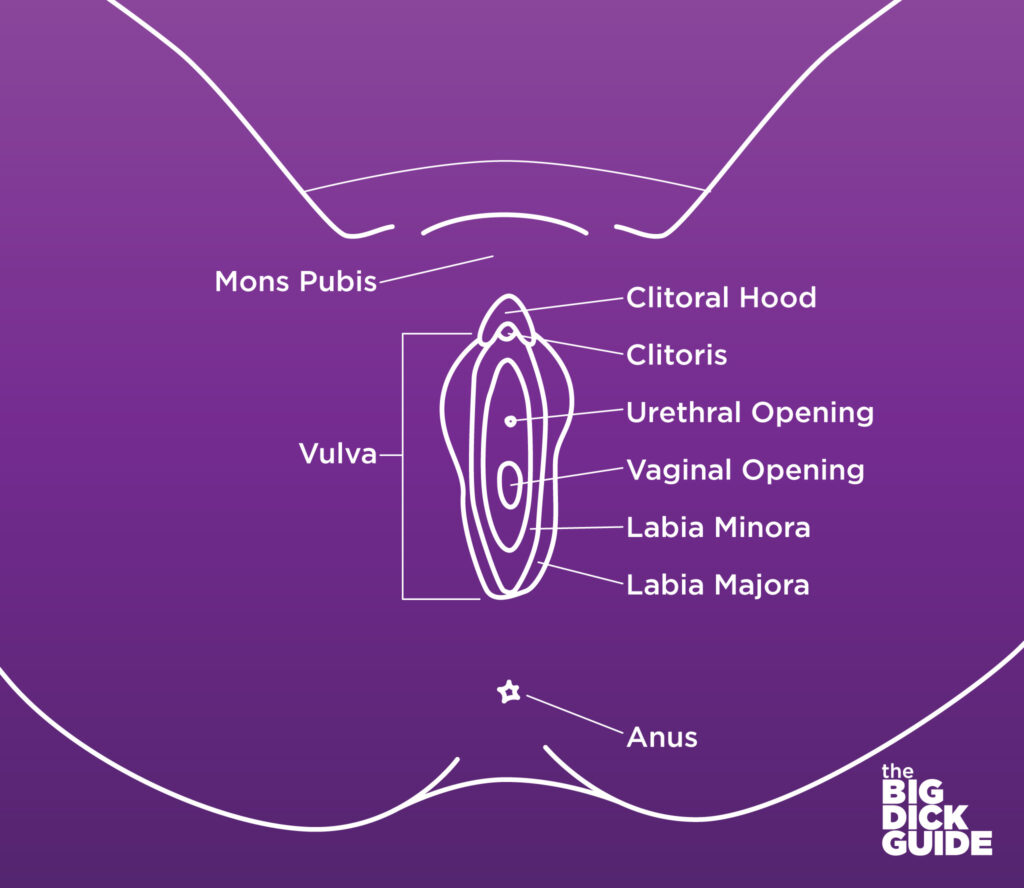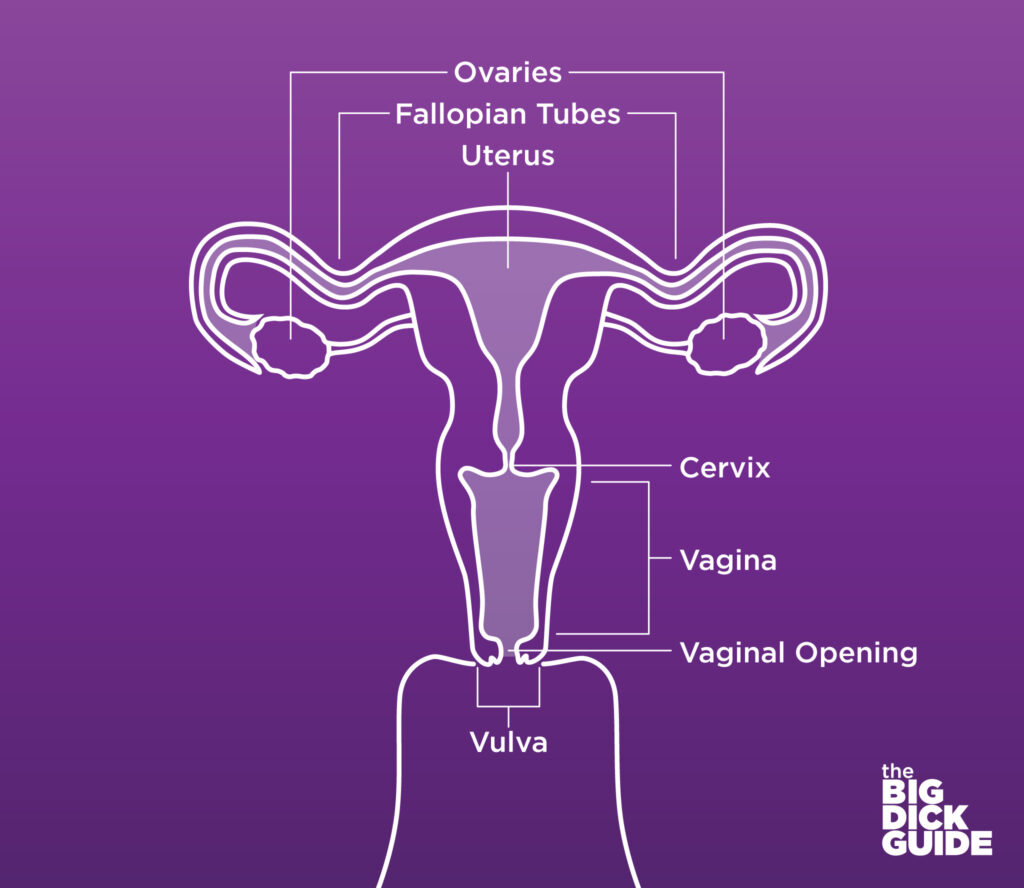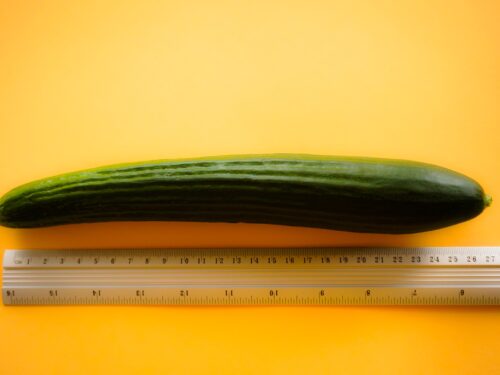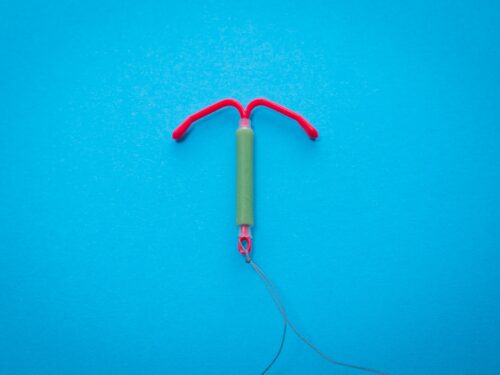The vagina is a wonderful thing, but too many seem to lack a basic understand of its layout and how it works. So let's take a look at how the female anatomy works and what you need to know before you dive in with foreplay.

Vagina
The vagina is the interior part of the female sexual anatomy that is used in sex. At the lower end is the vaginal opening inside the vulva, and at the top end is the cervix — the gateway into the uterus. Vaginas are muscular tubes with great ability to stretch — after all, it has to be able to pass a baby during childbirth. But the rest of the time it doesn't dilate nearly as much. Unaroused, the average vagina is about 3-4 inches deep and tight. Once fully aroused the vagina extends to around 6 inches in length and increases in diameter. Just as penises come in a wide range of sizes, so do vaginas. Most are average, sitting in a range of 5-7 inches long, while a few are shorter or longer, tighter or looser.
The human vagina evolved alongside the human penis and the two are sized for maximum compatibility. The average dick is 5.5 inches long, the average vagina is 6 inches deep. Crazy, eh?
Vulva
The vulva consists of all of the external genitalia surrounding the vaginal opening. On either side of it are the labia, with the clitoris, urethral opening, and vaginal opening lined up down the middle, front-to-back. Beyond that point you'll find the perineum (taint) and the anus.
Clitoris
While the vagina gets a lot of attention, the focus should really be on the clitoris. It is one of the most important and yet often neglected parts of the female anatomy.
The clit is best understood by men as the female equivalent of the penis, except even more sensitive. During fetal development the two organs evolve from the same cells in the early embryo. Though much smaller than a penis, the clitoris still has a shaft and a glans, and is even covered by a clitoral hood not unlike a foreskin. The clitoris even fills with blood and becomes larger and erect when the woman is aroused.
Across the small surface of the clitoris there are approximately 8,000 nerve endings — twice as many as you'll find on a penis. The concentration of nerves here makes the clit extremely sensitive, making it often the focus of masturbation and foreplay for women.
Labia
Stretching down from the clitoral hood to just past the vaginal opening are the labia. These “lips” are the folds of skin and can take on very different appearances from one woman to another. They can be darker in color than the surrounding skin. There are two layers to the labia: the labia majora and labia minor. The labia majora are the outer lips and tend to be plump, usually enclose most of the vulva, and tend to be covered with pubic hair. The labia minor are the inner lips that directly surround the vaginal opening and urethra. When aroused, the labia will swell with increased blood flow to the genitals, slightly opening the vulva.
For some women the labia are tight against the body, in others they hang more. The shape and elasticity of the vagina has nothing to do with her sexual past; the labia are highly elastic and aren’t permanently stretched out from having sex with many partners or with a particularly large penis.
Mons Pubis
Completing our tour around the vulva is the mons pubis, otherwise known as the pubic mound. It is a spot of fatty tissues located directly above and to the sides of the vulva, and is covered with pubic hair. It provides a padding over the pubic bone and clitoris to dampen impacts during aggressive sex.
Hymen
The hymen is a thin layer of tissue around the vaginal opening, typically widest at the bottom end. It does not fully enclose the vagina (that would make mensuration difficult), and isn’t always torn during the first intercourse. For some women the hymen is elastic or small enough that it is never broken, while for others it may be particularly thick and prove a source of pain during sex.

G-Spot
Just inside the vagina is the vaunted G-spot, named for early 20th Century gynecoligist Ernst Gräfenberg who was among the first to scientifically document its existence. It is a a highly sensitive patch of tissue that when properly stimulated is very arousing. G-spot stimulation alone can lead to strong orgasms. You'll find the G-spot on the front side of the vaginal wall about 2-3 inches / 5-8 cm in. It has a bumpier texture than the general smoothness of the rest of the vaginal wall. It's worth noting that not all women have an easily stimulated or located G-spot.
The G-spot's sensitivity comes from the fact that it is the underside of the base of the clitoris. It's not as sensitive as the exterior portion of the clit, but it is still very sensitive. The G-spot can be stimulated by deft application of toys, fingers, or penises (curved dicks have an advantage in reaching the G-spot over their straighter brothers).
A-Spot and P-Spot
Otherwise known as the anterior and posterior fornix, the A-Spot and P-Spot are both located at the top end of the vagina. They are recesses on the front (anterior) and back (posterior) side of the cervix, and for some women are highly erogenous. The problem is that they are located on either side of the cervix, which for many women is very painful to even have touched, so if you're probing for the A-spot or P-spot you may be in dangerous territory.
Cervix
The cervix is located at the top end of the vagina. It is a small donut-shaped ring of muscle that serves as the passageway into the uterus, and most of the time that passageway is tightly closed. The stiffness of the cervix is different than the rest of the generally-soft vagina; the cervix has about as much give as the tip of your nose.
Most women find touching the cervix to be painful, especially during intercourse when it may be repeatedly rammed by a longer penis. A small portion of women find cervical stimulation to be pleasurable, some in the "good pain" sort of way.
The cervix's placement at the top end of the vagina means that its depth changes based on how aroused the woman is. As a woman becomes more turned on the vagina lengthens in preparation for intercourse, on average expanding from 3-4 inches deep to around 6 inches, with the cervix at the back end of that. This puts the cervix, along with the A-spot and P-spot, out of reach of the average 5.5-inch-long penis, which makes sense considering that the human penis and vagina evolved alongside each other for maximum compatibility. Men with longer-than-average penises can more easily reach the cevix, and thus need to be careful about their thrust depth and angle to avoid impacting the cervix in most women. A penis depth limiter or bumper can help to reduce the penetration depth and keep the cervix out of reach.
Intrauterine contraceptive devices (IUDs) are placed through the cervix into the uterus. There are two types of IUD: time-delayed hormone release that interferes with part of the menstrual process and makes pregnancy next-to-imposssible and copper coils that trigger a minor inflammatory reaction that kills both eggs and sperm before fertilization can occur. IUDs have two thin plastic strings that extend through the cervix in case the doctor needs to remove the device in the future, the strings are typically cut so 1-2 inches are left protruding.
Uterus
Technically we're getting past the vagina and its accompanying bits at this point, but it's important to have a full understanding of female anatomy.
On the other side of the cervical passageway from the vagina is the uterus. This muscular cavity is where human life is developed. After an egg is fertilized by the male's sperm, the now-called-zygote is delivered to the uterus where it will develop into an embryo and then a fetus. After roughly nine months of development, the uterine muscles contract repeatedly through the labor process to deliver the baby human through the cervix and vagina.
Fallopian tubes
The fallopian tubes are a pair of ducts that stretch from the ovaries to the uterus. They are the passageway through which sperm must travel to reach the egg, and through which fertilized eggs are delivered to the uterus for fetal development and unfertilized eggs for disposal. Fertilization typically happens in the upper reaches of a fallopian tube when egg and sperm happen to meet. The interior of the tubes are covered in tiny hair-like protrusions called cilia that carry the egg down the duct.
Ovaries
Located at the end of each fallopian tube you'll find the ovaries. These egg-shaped organs are the female equivalent of the male testicle, producing the egg cells used for fertilization and hormones necessary for both the sexual processes and the body as a whole.
Ovaries are the production site for eggs (ovum) through a process called oogenesis. Unlike the testicles, which are constantly pumping out millions of sperm every day, the ovaries work on a slower time scale, between the two of them typically producing one matured egg cell on a rougly once-a-month schedule in a follicle on the ovary's surface. When the egg is fully matured it ruptures through the follicle and is released into the fallopian tube (this process is ovulation) for fertilization by sperm.
Ovaries also produce estrogen, inhibin, and progesterone hormones, as well as testosterone. Estrogen is responsible for the development of female sexual organs. Inhibin helps to regulate the menstrual process. Progesterone is a natural steroid hormone that serves numerous purposes in the female body, working with menstruation, pregnancy, and lactation. Though widely regarded as a "male" hormone, women also rely on lower levels of testosterone for bone and muscular health, cognitive function, and their libido.
Eggs
The human "egg" isn't anything like an egg like you would get from a chicken. In a human, the egg is a single reproductive cell (a gamete) containing half of the chromosomes and half of the genetic code (one side of the DNA sequence, known as RNA) needed to create a human. The other half is provided by a single sperm cell from the male.
After production in the ovaries, the egg is released into the fallopian tube. It takes 3-4 days for the egg to journey through the fallopian tube and enter the uterus, during which time it is open to fertilization by a sperm. When a sperm meets and egg, the two fuse together and the plasma membrane of the egg rejects any further bindings. The sperm containes enzymes that dissolve through the outer layers of the egg and its core enters the cytoplasm of the egg cell, leaving behind its recognizable case and tail. The inner cell membranes merge, followed by the merging of the cell nuclei and the RNA provided by the egg and the sperm join to create a new, unique DNA sequence. Cellular replication and division then rapidly begins as the bundle of undifferentiated cells migrates from the fallopian tube into the uterus where it will develop into a baby.
Menstrual cycle
On average, every 28 days a woman goes through a full menstrual cycle. This process is how the female body prepares for a possible pregnancy, and involves every part of the female reproductive system. Women generally experience menstuation on a regular schedule from the start of puberty (typically around 8 years old, but it can start as early as 8 or as late as 16) until they arrive at menopause and the ovaries stop producing eggs (typically around 50) and the woman can no longer become pregnant. The menstrual cycle happens in four distinct phases, but is continuous so you can't pin down any one phase as the "starting point".
Menstruation is the shedding of the thickened uterine lining (endometrium) that was prepared to support a possible pregnancy. The mucus, blood, and enometrial cells are expelled through the cervix and vagina over the course of 3-7 days. This is commonly referred to as a woman's "period", and she may use tampons, pads, or menstrual cups to contain the flow without making a mess of her clothing.
The follicular phase starts alongside menstruation, during which the ovaries are stimulated by the release of hormones to produce the follicles that will create the eggs. During this phase the lining of the uterus is refreshed with new enometrial cells and mucus.
Ovulation follows with the release of a single cell from the surface of an ovary. The egg is carried down the fallopian tube, where it will take 3-4 days to travel to the uterus. During ovulation a woman is at her peak fertility and stands the highest chance of becoming pregnant, specifically within the first 24 hours after the release of the egg; after which point the typically die if unfertilized.
After the release of the egg, the luteal phase begins as the follicle on the ovary in which the egg was produced transforms into a corpus luteum and produces the hormone progesterone to maintain the thickened uterine lining in preparation for the implantation of a fertilized egg. If a fertilized egg manages to implant in the uterine lining, the corpus luteum will endure and continue producing hormones to support the pregnancy and halt the menstual cycle. If a fertilized egg does not implant, then the corpus luteum will die and cease producing progesterone, prompting the menstruation shedding of the uterine lining. And then the cycle repeats anew.











